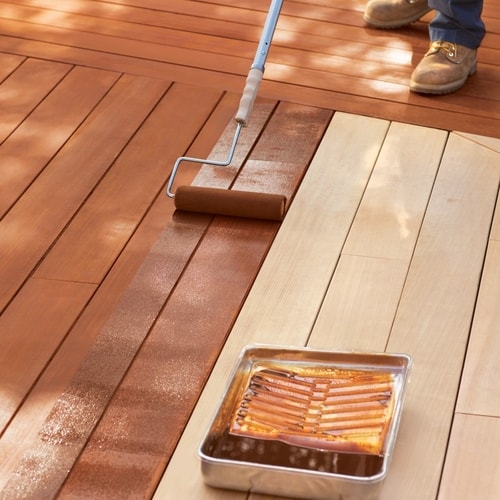Choosing the Right Deck Stain: Boost and Shield Your Deck
Choosing the Right Deck Stain: Boost and Shield Your Deck
Blog Article
A Comprehensive Overview to Different Kinds of Deck Discoloration Techniques for Ultimate Security and Visual Appeals
In the world of deck maintenance, the art of tarnishing stands as a crucial action towards both preserving the honesty of your outdoor area and improving its aesthetic charm. As we browse with the complex globe of deck discoloration techniques, one starts to appreciate the nuanced techniques that can make all the difference in between an average coating and a flawless one.
Comprehending Various Sorts Of Stains
Numerous kinds of stains are frequently utilized in the procedure of deck discoloration to accomplish various aesthetic and protective effects. Clear discolorations are excellent for showcasing the natural grain of the timber while offering very little protection versus UV rays and dampness. On the various other hand, semi-transparent stains use an equilibrium in between color improvement and security, enabling some wood grain to show with. For an extra opaque surface that offers optimum security against the aspects, strong spots are the recommended option. These stains can be found in a vast array of colors and successfully conceal the timber grain.
Toners include a tip of color to the timber while providing minimal defense, making them ideal for newer decks with much less wear. Recognizing the qualities and advantages of each type of discolor is important for accomplishing the desired appearance and durability for your deck.
Picking the Right Spot Shade
When thinking about the aesthetic appeals of your deck staining project, the selection of stain color plays a vital role in improving the safety top qualities of the picked tarnish type (Beautiful Deck). The color you select can significantly affect the overall appearance of your deck, in addition to its capacity to hold up against the aspects with time
When choosing a discolor color, it's crucial to take into consideration the existing color pattern of your home's outside. Balancing the deck discolor with the total aesthetic of your building can produce a cohesive and aesthetically attractive outdoor area. In addition, the color of your deck tarnish can affect the temperature level of the deck surface area; darker colors tend to take in more warmth, while lighter shades mirror sunlight and remain cooler.
Furthermore, the kind of wood you are staining will likewise influence just how the discolor color appears. Various timber varieties can engage with the tarnish in various methods, possibly modifying the last color. It's suggested to evaluate the tarnish on a little, inconspicuous area of the deck to ensure the color transforms out as desired prior to waging the whole project.
Preparing Your Deck for Staining
To make certain a successful and resilient deck staining task, comprehensive preparation of the deck surface is important. Begin by cleaning the deck extensively to get rid of dust, grime, mold, and any kind of old finish or stain.
Examine the deck for any kind of damaged or rotten boards that require to be replaced. Hammer down any kind of extending nails and sand any kind of rough locations to guarantee a smooth surface for staining. Inspect for any kind of loose barriers or actions that might require tightening up or fixing.
When the deck is tidy, completely dry, and in good repair service, consider applying a timber brightener to restore the deck's all-natural shade and open the wood pores for look here much better stain infiltration. Lastly, protect any kind of close-by plants, furnishings, or surfaces with plastic sheet prior to proceeding with the staining process. Appropriate preparation is essential to attaining a professional-looking coating and maximizing the durability of your deck stain.
Using Spot With Various Techniques
For a specialist and flawless finish, the technique of applying discolor plays an essential function in boosting the appearance and durability of your deck. There are numerous strategies you can utilize to ensure an effective application of tarnish.
Cleaning is a conventional method that enables precision and control over the amount of discolor applied. It is perfect for complex locations and getting to between deck boards (Beautiful Deck). Rolling is a quicker alternative, covering bigger surface area areas successfully. Nonetheless, back-brushing after rolling is suggested to level the tarnish and work it into the wood for much better infiltration.
Spraying is an additional prominent strategy, offering rate and ease of application, particularly for large deck locations. Whichever method you choose, making sure proper prep work and complying with maker guidelines will certainly help accomplish a resilient and beautiful tarnish surface on your deck.

Keeping and Re-staining Your Deck
When it comes to re-staining your deck, the frequency depends on different factors such as the kind of stain made use of, the climate in your location, and how much wear and tear your deck experiences. Typically, it is advised to re-stain your deck every 2-4 years to preserve its security and appearances.
Prior to re-staining, ensure the deck is clean, completely dry, and discover this info here complimentary of any kind of previous tarnish residue. Pick a high-grade discolor that fits your deck's product and supplies the desired degree of security.
Conclusion
In final thought, understanding the different kinds of deck stains, selecting the ideal color, properly preparing the deck, using tarnish with different methods, and re-staining the deck and maintaining are necessary steps for best defense and visual appeals. By adhering to these steps, you can ensure that your deck remains in leading condition for many years to find.
Furthermore, the color of your deck discolor can affect the temperature of the deck surface; darker shades often tend to soak up more warmth, while lighter colors reflect sunlight and stay cooler.
It's recommended to test the stain on a small, low-profile area of the deck to ensure the color turns out as desired prior to continuing with the whole job.

Report this page